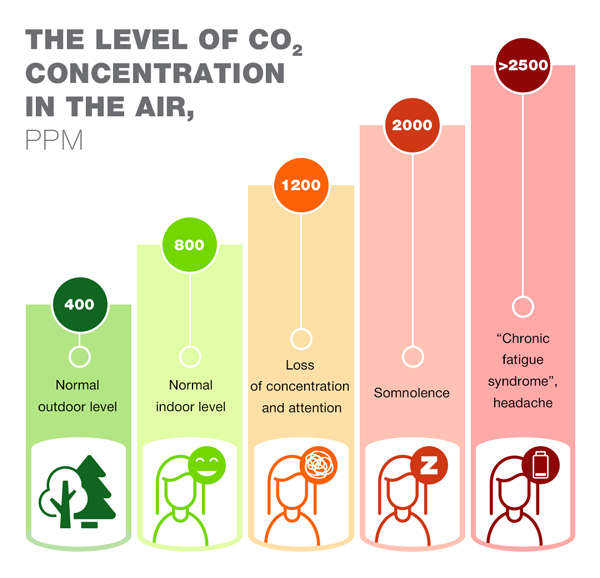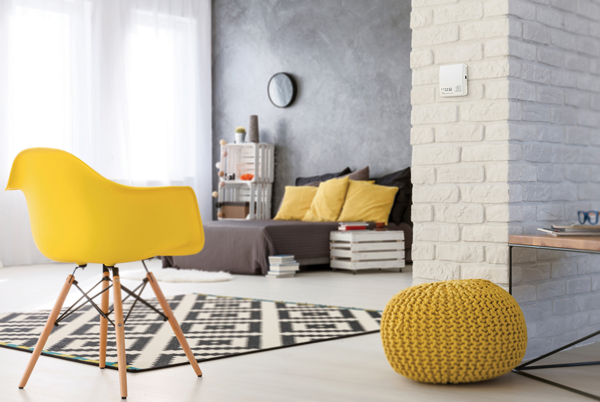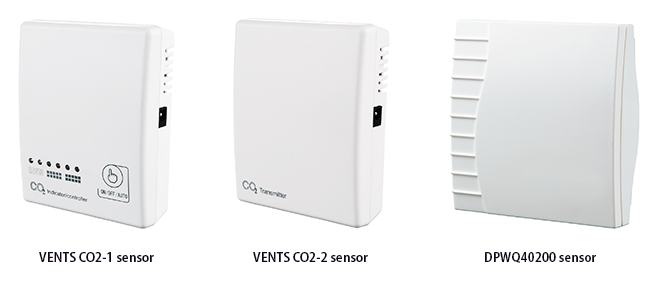How to ensure healthy air at home? Part 2
Part one: Humidity and humidity sensors
Part two: Carbon dioxide and СО2 sensors
Another important air quality parameter is the volume fraction of carbon dioxide (СО2), the main source of which is people generating it through breathing. In a poorly ventilated room with people present, this parameter is gradually increasing together with humidity. Therefore, the more people are present in the room, the faster the concentration of this harmful gas will increase. Consequently, it is very important to monitor CO2 concentration in the air and to organize such air exchange that would ensure a comfortable level of its content.
The most comfortable air for a person is considered outdoor air containing approximately 0.04 % of carbon dioxide or 400 ppm (parts per million). In a room with people, CO2 content rise is inevitable, while its increase to 0.08 % (800 ppm) does not affect a person’s wellbeing in any way and such air can be considered normal. When CO2 concentration reaches range of 0.08–0.10 % (800–1000 ppm), such air quality is now considered mediocre. With such CO2 concentration in the air, some people may feel slight general discomfort. When CO2 concentration reaches the range of 0.10–0.14 % (1000–1400 ppm), a person may start feeling fatigue, experience laboured breathing, problems with the nasopharynx, as well as troubles with maintaining attentiveness and information processing. In most countries, such CO2 content is considered as the lower limit of acceptable norm. When carbon dioxide content reaches over 0.14 % (1400 ppm), air quality is considered low. In such environment, a person can experience severe fatigue and lethargy, lack of initiative and apathy, problems with concentration and sleep. When CO2 content reaches over 0.2 % (2000 ppm), human body reacts to it even in a more pronounced manner: headaches and other ailments appear, a person experiences reluctance to work and engage in mental activity, may suffer from chronic diseases of the nasopharynx, etc. Prolonged stay in a room with carbon dioxide content within the range of 0.25–0.5 % (2500–5000 ppm) may lead to serious health problems. As a result of constant impact of high CO2 concentration, an increase in blood acidity occurs, which can lead to acidosis – a shift in the acid-base balance of the body towards an increase in acidity. Acidosis can provoke such diseases as diabetes, problems with the musculoskeletal and cardiovascular systems, general weakness.
There is a widespread belief that airing of the room is performed with the purpose of replenishing the supply of oxygen, which is gradually decreasing due to its constant human consumption. This is partially true, but more important result of airing is the removal of excess carbon dioxide from the room. It is known that in order to be comfortable for humans, the air should contain 20.9 % oxygen. At the same time, oxygen content decrease to 15 % or an increase to 80 % does not significantly affect the human body. The same cannot be said for the carbon dioxide because even a small change in its concentration by 0.1 % has a noticeable negative effect on a person. That is why controlling carbon dioxide concentration in the air is very important, especially in pre-school facilities and in schools. It is no secret that many schools are still not equipped with forced ventilation systems and airing is done by simply opening windows. Controlling of СО2 levels allows identifying increased carbon dioxide concentration and ensuring better ventilation within the facility, and therefore improving students wellbeing and mental functions, as well as their perception of information taught.
SOLUTION. A special carbon dioxide sensor allows identifying СО2 concentration within a room. This device is useful in residential, office and commercial premises with large crowds of people, such as in classrooms, conference-halls, etc. Such sensors may operate as both standalone devices and as integrated parts of ventilation equipment. In the latter case, it allows ventilation equipment to automatically turn on and off and to change its operation mode depending on carbon dioxide concentration within the room. There are sensor modifications equipped with a mode switch and LED lights for CO2 concentration, which allows activating the ventilation only when it is necessary, i.e. when the indicator is triggered.
The VENTS CO2 sensor is designed for indoor carbon dioxide concentration measurement and air capacity control of ventilation equipment based on CO2 concentration. The sensor has two separate outputs: a normally opened dry relay contact and an analogue output–10 V. The relay output is used to turn the ventilation equipment on/off depending on indoor CO2 concentration and the analogue output is used for smooth fan speed control for a fan with EC motor or a fan with extra speed controller with 0–10 V input. In case of smooth fan speed control the fan speed varies proportionally to carbon dioxide emissions. The relay and analogue outputs make the sensor compatible with any ventilation system. The integrated self-calibration system ensures reliable sensor operation during the sensor service life.
The sensor is available in two modifications: VENTS CO2-1 and VENTS CO2-2. The CO2-1 model incorporates built-in LED lights for CO2 concentration and an operation button. Three modes are provided: on, off, operation by CO2 concentration. The button is used to switch the ventilation equipment on or off when CO2– based ventilation control is not required. The CO2-2 model has no LED-lights and on/off button. This model is applied for premises requiring permanent ventilation, i.e. at school classes and other public premises.
Self-calibrating sensor DPWQ40200 with microprocessor control for measuring carbon dioxide content in the air within the range from 0 to 2,000 million-1 (parts per million). The sensor has 2 analogue outputs (0–10 V and 4–20 mA), which allow stepless fan speed control. With stepless control the fan speed is changed in proportion to carbon dioxide concentration changes. The CO2 content in the air is measured by means of a non-dispersive infrared analyser (NDIR).
To be continued…








